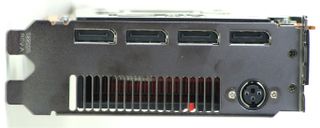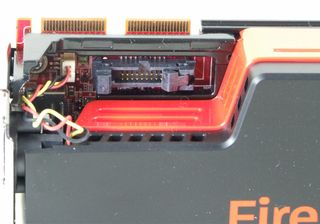Workstation Shootout: Nvidia Quadro 5000 Vs. ATI FirePro V8800
Nvidia sure didn't waste any time introducing its Fermi architecture to the workstation space. Its Quadro 5000 is one of the first models to use the company's GF100 graphics processor. How does this card stack up against ATI’s flagship FirePro V8800?
ATI FirePro V8800: Features, Connectors, And Driver

Our FirePro V8800 sample completely eschews DVI. Instead, the card sports four DisplayPort connectors, allowing four displays to be used in parallel. As on the desktop, this feature is referred to as EyeFinity.

Considering the small installed user base, a DisplayPort-only design is a rather bold move. After all, most folks still have a monitor with a DVI cable sitting on their desk. There‘s no need to worry, though, as ATI includes two active single-link adapters with the card that can translate the DisplayPort output to a DVI signal. Since DisplayPort and DVI are not compatible on the physical protocol level, these need to be active adapters, with a circuit translating the signal from one protocol to the other.
As a side note, DVI-to-HDMI adapters (or vice versa) don’t need an active circuit, since in both cases, the video signal is based on the PanelLink protocol. Instead, you just need an adapter that contains connections linking the various pins for each plug correctly.

The FirePro V8800 also features a 3-pin connector for stereoscopic 3D glasses. Again, that doesn’t necessarily mean the glasses have to be connected by wire. Instead, a little transmitter that synchronizes the stereoscopic images will do just as well.
AMD can put checkmarks in all the important feature boxes, including Shader Model 5.0, DirectX 11 and OpenGL 4.1. The company knows just as well as Nvidia that modern graphics processors are capable of much more than just rendering pretty pictures. The high transistor count and the many shader cores make current GPUs an attractive choice for scientific calculations. While Nvidia is actively promoting its proprietary CUDA API for GPGPU work (general purpose graphics processing), AMD has all but dropped its Stream API, choosing instead to back the OpenCL standard. While that move is laudable on paper, it’s not like developers are falling over themselves to create software that makes use of OpenCL (yet).

Nvidia, for its part, regularly promotes CUDA at universities, scientific institutions, and to its partners in various industrial sectors in order to inspire developers to use its programming language. And yes, that includes financial support as well.
AMD offers an add-in card for specific usage scenarios called the FirePro S400. Production companies working in the broadcasting sector need Framelock and Genlock when working across several monitors in parallel. The S400 offers this type of synchronization.
Stay on the Cutting Edge
Join the experts who read Tom's Hardware for the inside track on enthusiast PC tech news — and have for over 25 years. We'll send breaking news and in-depth reviews of CPUs, GPUs, AI, maker hardware and more straight to your inbox.
The FirePro V8800 is rated with a TDP of 208 W and satisfies its power requirements through two 6-pin auxiliary power connectors. The card also comes with a CrossFire connector that allows two V8800s to be used in parallel.


Current page: ATI FirePro V8800: Features, Connectors, And Driver
Prev Page ATI FirePro V8800: Overview Next Page Test Configuration-
tacoslave if amd put a little more work on their drivers (i.e crossfire and firepro performance)they would be the clear performance champion.Reply -
Gin Fushicho I really wish I knew what these numbers meant.Reply
For someone who doesn't do 3-D design these benchmarks are kinda confusing. -
joytech22 You need to remember, Fermi is designed not "Just" for games, but was also designed, from day one, with computing in mind as well.Reply -
SchizoFrog Once again the arguement regarding AMD Drivers is brought to the fore. But more than this, when AMD has a line of products that could be said to 'miss' they absolutely FAIL. nVidia on the otherhand seem to have learned their lesson well from the 5xxxFX series and can still produce products that can compete at least at some level, ie: GTX460. Although these are Workstation products, nVidia have a complete package with GPUs and Drivers that work from the off.Reply -
davefb sort of interesting, but why is there no comparison to mainstream boards? There is a massive premium of cost here but nothing to be able to say 'hey boss, the onboard graphics we use really don't cut it any more, how about a quadro'.Reply
(or have I sped-read past the reason why ;) )
Most Popular


